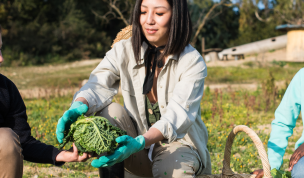Time to boost calcium in the diets of Aussie Children

Aussie children will learn the importance of developing stronger bones, thanks to new cutting-edge technology in Life Ed school programs.
The new 3D body flythroughs of the skeletal system are being launched to mark the start of Healthy Bones Action Week and will be a regular feature in the Healthy Harold classes right across Australia.
Life Ed CEO Kellie Sloane thanked partner Dairy Australia for supporting the development of the fun and strikingly realistic 3D resource, known as TAM-e.
“Healthy Harold now has a colourful interactive companion in TAM-e to show children the benefits of the best possible choices for eating well and exercising,” Ms Sloane said.
Healthy Bones Action Week will focus on:
- Calcium intake through foods like milk, cheese, yoghurt
- Weight bearing exercise, such as a hop, skip or jump
- Vitamin D from safe sunshine
Nutrition Australia’s Leanne Elliston said calcium is essential for growing and maintaining healthy bones.
“Over half of the Australian population aged two years and over have inadequate intakes of calcium which is a real concern as this can result in poor bone density and increased risk of osteoporosis and bone fractures,” Ms Elliston said.
“Whilst calcium can be found in a wide variety of foods, dairy foods such as milk, cheese and yogurt are our richest and easily available food source.”
The Australian Dietary Guidelines encourages the inclusion of milk, yoghurt, cheese and/or alternatives such as almonds, canned fish and tofu, every day, to ensure an adequate intake of calcium.
Nutrition Australia says primary school aged children should aim for around 2-3 serves of dairy every day to meet their calcium needs
“That could look like a glass of milk at breakfast, a 200g tub of yoghurt for morning tea and a slice of cheese in a sandwich for lunch,” Ms Elliston said.
More about TAM-e
TAM-e is a virtual anatomical model. Life Education use TAM-e to teach children about the human body. With TAM-e we can see inside the brain, fly through the heart, see what happens inside the lungs when a person is having an asthma attack and follow the digestion of food- from one end to the other!
We also have an augmented reality feature will allow students to “see” the heart, brain, stomach and lungs as if they are “popping” out of their bodies.
TAM-e features many body systems – circulatory, nervous, digestive and respiratory but didn’t have bones.
Thanks to Dairy Australia, TAM-e now has a skeletal system and new interactive assets to show how calcium goes from the digestive system to the bones and how bones repair. Growing bones need calcium to help them be strong! Children and young people need plenty of calcium to support their growing bones.
Children are fascinated by bones and skeletons- being able to show them a close-up of their bones with the TAM-e technology this is an exciting addition to Life Ed’s suite of resources.











